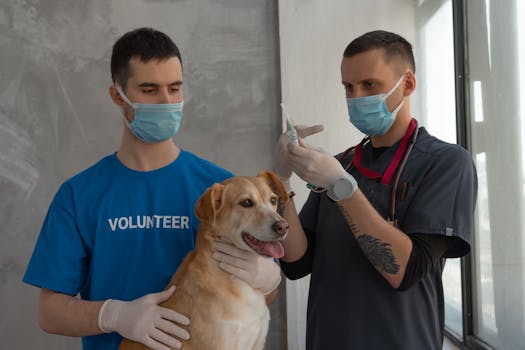
data-usecase-icon="recurring_donations"
Lancer un programme de parrainage d'un animal de compagnie âgé
Invitez les donateurs à soutenir mensuellement l'alimentation et les soins médicaux des animaux retraités, garantissant ainsi des fonds stables pour les besoins courants. Grâce à ces dons récurrents, les queues des animaux restent frétillantes et les factures sont réglées tout au long de l'année.
data-usecase-cta="recurring_donations" (dons récurrents)
data-usecase-icon="donation_form"
Lancer une collecte de fonds pour les vétérinaires en situation d'urgence
Utilisez un formulaire de don personnalisé pour collecter des dons ponctuels pour des traitements médicaux et des réhabilitations urgents. Le paiement rapide permet de s'assurer qu'aucun animal ne souffre dans l'attente d'un financement.
data-usecase-cta= "donation_form"
data-usecase-icon="peer_to_peer"
Organiser une marche de pair à pair (Tail-Wag Trot)
Mobiliser les sympathisants pour collecter des parrainages en vue d'une course à pied communautaire au profit d'animaux de sauvetage à la retraite. Les pages peer-to-peer amplifient la portée de l'action et alimentent les réseaux de donateurs.
data-usecase-cta="peer_to_peer"
data-usecase-icon="event"
Vendre des billets pour un défilé et un pique-nique d'animaux âgés
Organisez un rassemblement en plein air où les adoptants et les sympathisants se mêlent aux animaux âgés tout en profitant de camions de nourriture et d'activités. Les billets payants couvrent les coûts de l'événement et génèrent des fonds pour les soins continus.
data-usecase-cta="event"
data-usecase-icon="store"
Ouvrir une boutique de sauvetage en ligne
Proposez des t-shirts, des calendriers et des jouets pour animaux faits à la main, à l'effigie des vedettes à la retraite de votre organisation de sauvetage. Chaque vente permet de promouvoir votre cause et de financer une literie douillette et des friandises spéciales.
data-usecase-cta="store"
data-usecase-icon="adhésion"
Créer un club de membres Golden Paws
Proposez des niveaux d'adhésion échelonnés avec des avantages tels que des mises à jour sur les coulisses, des rencontres réservées aux membres et des articles de marque. Un programme d'adhésion permet d'obtenir un soutien fidèle et des revenus fiables.
data-usecase-cta="adhésion"
Comment Zeffy se compare-t-il aux autres plateformes de collecte de fonds pour Sauvegardes d'animaux à la retraite
Frais | Vous gardez | Vous perdez | ||
|---|---|---|---|---|
0 % de frais de plateforme et de traitement | $50,000 | $0 | ||
2,9 % + 0,30 $/transaction | $48,400 | -$1,600 | ||
2,2 % + 0,30 $ + ~2,35 % de frais de plateforme | $47,500 | -$2,500 | ||
2,9 % + 0,30 $/transaction | $48,350 | -$1,650 | ||
3,7 % + 1,79 $/billet + 2,9 % de frais de traitement | $46,550 | -3 450 $ (estimation) | ||
1.99% + $0.49 | $48,560 | -$1,440 |
100% gratuit, toujours.
Les 6 meilleures idées de collecte de fonds pour Sauvegardes d'animaux à la retraite
🏖️ Marathon d'écorces au bord de la mer
Les supporters sont sponsorisés pour chaque kilomètre parcouru par les chiens retraités le long de la plage, ce qui permet de collecter des fonds et de sensibiliser l'opinion publique à la cause de votre refuge.
🎨 Vente aux enchères de portraits de chiots de sauvetage
Commandez ou enchérissez sur des portraits d'animaux personnalisés réalisés par des artistes locaux, dont les bénéfices sont reversés à des associations de sauvetage de retraités.
📱 #PawsitivePhoto Challenge
Encouragez les sympathisants à poster des selfies de leur animal de compagnie avec votre hashtag ; les sponsors font un don par post pour augmenter les fonds de sauvetage.
🌭 Pup & Picnic Pop-Up
Organisez un pique-nique dans un parc avec des camions de nourriture et des retraités adoptables ; les ventes de billets et les frais des vendeurs soutiennent votre mission.
🎶 Concert d'été Bark & Brew
S'associer à une brasserie pour organiser un spectacle en plein air adapté aux chiens ; la vente de billets et d'une partie des boissons permet de collecter des fonds.
🍦 Journée des glaces pour les pattes
Faites équipe avec un marchand de glaces local pour une vente de parfums d'un jour, en reversant les recettes à la prise en charge des animaux retraités.
Envie de plus d'inspiration ?
Découvrez plus de 40 sites gratuits Sauvegardes d'animaux à la retraite idées de collecte de fonds
Principales subventions pour Sauvegardes d'animaux à la retraite en 2025

Prix Better Together
Michigan Pet Alliance
$1,000 - $3,000
Ce prix récompense les organisations qui s'associent et collaborent pour sauver des vies et améliorer les soins aux animaux. Les candidatures doivent être envoyées au plus tard le 7 juillet 2025.

Programme de subventions de l'ASPCA
ASPCA
Jusqu'à 1,8 million de dollars
Soutient l'adoption dans les refuges et les sauvetages ; les catégories de subventions spécifiques et les dates limites varient, certaines étant ouvertes tout au long de l'année.

Subventions Petco Love
Petco Love
Non spécifié dans l'extrait
Soutient les initiatives en faveur du bien-être des animaux pour les refuges pour animaux de compagnie et les organisations d'adoption éligibles ; les détails de la demande sont disponibles sur le site web.

Walmart Community Grants (Spark Good Local Grant)
Walmart
Non spécifié dans l'extrait
Soutient des projets communautaires locaux, y compris ceux concernant le bien-être des animaux ; les cycles d'examen 2025 comprennent la période du 1er août au 15 octobre 2025 et la période du 3 novembre au 31 décembre 2025.
Principales entreprises qui font des dons à Sauvetage des animaux à la retraite en 2025

Fondation Pedigree
Offre des subventions aux organisations 501(c)(3) pour des programmes d'aide aux chiens.

Fondation Banfield
Soutient les organisations de protection des animaux qui fournissent des soins vétérinaires, des abris et des secours en cas de catastrophe aux animaux de compagnie dans le besoin.

Fondation Bissell pour les animaux de compagnie
Soutient les refuges et les organisations de sauvetage.

Petco Love
Soutient les organisations animales à but non lucratif qui s'occupent des animaux dans le besoin.
Questions fréquemment posées
Zeffy est-il vraiment 100 % gratuit pour les associations de protection des animaux à la retraite ? Quel est le piège ?
Oui, Zeffy est 100% gratuit pour les associations de sauvetage d'animaux à la retraite ! Vous ne payez pas de frais de plateforme, de frais de traitement ou de coûts cachés. Nous sommes soutenus par les pourboires optionnels des donateurs qui aiment ce que nous représentons et veulent s'assurer que vous gardez chaque dollar pour les animaux dont vous vous occupez. Il n'y a pas de piège !
Les associations de sauvetage d'animaux à la retraite peuvent-elles utiliser Zeffy pour collecter des dons ?
Absolument ! Les associations de protection des animaux à la retraite peuvent utiliser Zeffy pour collecter des dons généraux, mettre en place des dons récurrents et même vendre des billets d'entrée à des événements, le tout sans frais. La générosité de vos donateurs soutient directement le bien-être des animaux, sans perdre un centime en frais.
Quels types de campagnes de collecte de fonds peuvent être menés avec Zeffy ?
Les associations de protection des animaux à la retraite peuvent mener différentes campagnes avec Zeffy, notamment des collectes de fonds de pair à pair, des événements avec billets et des campagnes de dons récurrents. Que vous organisiez une vente aux enchères caritative ou que vous mettiez en place un programme de dons mensuels, Zeffy vous couvre.
Quelle est la meilleure plateforme de collecte de fonds pour les sauveteurs d'animaux à la retraite ?
Zeffy est le meilleur choix pour les associations de protection des animaux à la retraite qui recherchent une plateforme de collecte de fonds réellement gratuite à 100 %. Alors que d'autres plateformes cachent des frais ou des coûts en petits caractères, Zeffy garantit que chaque dollar collecté va directement à votre mission - prendre soin de ceux qui dépendent de vous.













